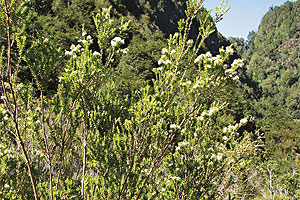The abundance of precipitations and humidity allow the development of the evergreen forest and the rain forest.
– The evergreen forest and the Valdivian jungle: the first develops at the region’s coastal zone and the Valdivian jungle stretches between the Bueno and the Llico rivers. These two forests are dominated by species such as the Oak tree (Nothofagus oblique), the Maitén (Maytenus boaria), the Myrtle (Luma apiculata), the Olivillo (Aextoxicon punctatum), the Ulmo (Eucrypphia cordifolia), the Laurel (Laurus nobilis), the Tepa (Laurelia philippiana), the Lingue (Persea lingue), the Tineo (Weinmannia trichosperma), the Coigüe (Nothofagus dombeyi), the Short Leaved Mañío (Saxegothaea conspicua),the Larch tree (Fitzroya cupressoides), the Guaitecas Cypress (Pilgerodendron uviferum) and the Andean Cypress (Austrocedrus chilensis).
Among the most outstanding fauna of this region are the Monito del Monte (Dromiciops gliroides), the Pudú (Pudu pudu), the Chilote Fox (Pseudalopex fulvipes), the Cougar (Puma concolor), the Guiña (Felis guigna), the Huillín or Otter (Lontra provocax), the Long-nosed caenolestid (Rhynocholestes raphanurus), the Lesser Grison (Galictis cuja), the Grey Fox (Pseudalopex griseus), the Bobcat (Oncifelis geoffroy), the Coipo (Myocastor coypus) and the Chingue (Conepatus chinga). Also, numerous birds inhabits this region, such as the Black-Necked Swan (Cygnus melancoryphus), the Choroy (Enicognathus leptorhynchus), the Kingfisher (Ceryle torquata stellata), the Southern chesnut-throated Huet Huet (Pteroptochos tarnii) and the Southern peregrine falcon (Falco peregrinus cassini).
– Laurifolius, mixed and umbrofile forests with undergrowth: we find them at the intermediate depression sector. They are dominated by species such as the Oak tree (Nothofagus oblique), the Laurel (Laurus nobilis), the Lingue (Persea lingue), the Tepu (Tepualia stipularis) the Myrtle (Luma apiculata), the Olivillo (Aextoxicon punctatum), the Larch tree (Fitroya cupressoides), the Coigüe (Nothofagus cordifolia), the Ulmo (Eucrypphia cordifolia), the Hazelnut (Gevuina avellana) and the Male Mañio (podocarpus nubigena).
Regarding the fauna stands out the Tree rat (Irenomys tarsalis), and some birds as the Concón (Strix rufipes rufipes), the Diuca (Diuca diuca), the Chucao (Scelor|chilus ruibecola rubecola) and the Non flying Quetru (Tachyeres pteneres).
– Southern caducifoil forest: it appears at the Andean sector prevailing species such as the Larch trees, Lengas, Coigües and Ñirres.
Among the fauna, stands out mammals such as the Cougar (Puma concolor), the Patagonian Grey Fox (Pseudalopex griseus), the Vizcacha (Oligoryzomys longicaudatus) and the Huemul (hippocamelus bisulcus). Some of the birds inhabiting this place are the Black Woodpecker (Campephilus magellanicus), the Choroy (Enicognathuis leptorhynchus), the Hawk (Geranoaetus melanoleucus australis), the Cachaña (Enicognathus ferrugineus minor) and the Condor (Vultur gryphus).
Protected areas
– The Chiloe National Park: it was created on 1982 and is located at the Chiloe island western sector. It has a 43.057 hectares surface. The most attractive places of the park are the Cucao lake, the dunes, and the Metalqui island with its sea-lions colony, the Huelde lake and the Cole-Cole sector, which has a beach suitable for fishing.
– Vicente Perez Rosales National Park: is the oldest in the country for it was created on 1926. It has a 231.000 hectares surface and is located at 60 km from Puerto Varas (province of Llanquihue). Is surrounded by the Osorno, Tronador and Puntiagudo volcanos and includes the Todos los Santos and Llanquihue lakes. There are beautiful evergreen forests in this park and also the spectacular Petrohue river waterfalls.
– Andean Larch Tree National Park: it was created on 1982 and is located at 46 km southeast Puerto Montt, at the Reloncavi estuary. It has a 39.255 hectares surface where predominates the Larch tree forests. Nevertheless, there are other species such as the coigües, lengas, mañíos, canelos and tepas. Besides, this park has about fifty lagoons; among which, the most outstanding are Sargazo, Chaiquenes, Triangulo, Fria and Pangal.
– Hornopiren National Park: it was created on 1988, and is lo0cated 105 km from Puerto Montt, in the Hualaihue comuna 8county). It has 48.2322 hectares surface and its main attractions are the Yates (2.187 masl) and Hornopiren (1.572 masl) volcanoes and the Negro and Blanco rivers, the General Pinto Concha lake and few glaciers and snowdrifts.
– Palena Lake National Park: located at 24 km from Palena was created on 1965. It has 49.415 hectares and its landscape is dominated by the Palena lake, one of the many shared with Argentina (at the trans-Andean side is called General Vintter or General Paz). Besides, many ice snowcaps and a lenga forests can be observed.
– Llanquihue National Reservation: it was created on 1912 and is located at 60 km eastwards Puerto Montt. It has a 33.972 hectares surface and the Calbuco volcano is located in it, as well as a great amount of vegetal species such as Larch trees, tepas, mañíos, coigües and lumas.
– Futaleufu National Reservation: it was created recently on 2000, is located at the border with Argentina at 5 km from the Futaleufü locale (province fo Palena). It has 12.065 hectares and is characterized for lodging the southernmost Andean Cypresses species in Chile. Besides, is an area inhabited by huemules.








 Muere Evita
Muere Evita